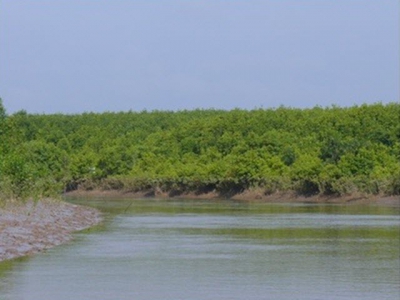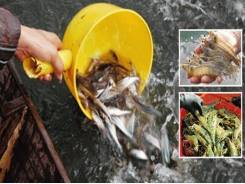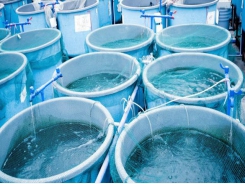Mangrove forests used to breed aquatic species

A mangrove forest in Trà Vinh Province’s Duyên Hải District. The province is encouraging farmers to develop mangrove forests and breed aquatic species. – Photo travinh
TRÀ VINH — Farmers in Trà Vinh Province’s coastal areas expanded the breeding of shrimp and other aquatic species to an additional 1,700ha of mangrove forests this year, according to the province’s Department of Agriculture and Rural Development.
The breeding in mangrove forests, which now totals 5,780ha, is sustainable and protects the environment against the effects of climate change, said the department.
Farmers only need to buy shrimp and fries for breeding since the aquatic species eat wild food in the forests.
Farmers normally breed shrimp with a density of 15 – 20 shrimp per sq.m in mangrove forests.
Duyên Hải District has about 5,100ha of mangrove forests used for breeding aquatic species, the province’s largest area, according to the district’s Agriculture and Rural Development Division.
Ngô Oanh Rương, who has a one-ha mangrove forest in Duyên Hải District’s Đông Hải Commune, breeds about 20,000 black-tiger shrimp and 3,000 mud crabs in his forest every year.
Last year, he harvested 500 kilogramme of black-tiger shrimp and earned a profit of VNĐ150 million (US$6,450) from the shrimp, he said.
The model yields high profits and protects the environment, he said.
Lâm Thành Nam, who has implemented the model on 4ha in Duyên Hải Town’s Hiệp Thạnh Commune for nearly 10 years, said he had planted mangrove species like black mangrove, grey mangrove and spotted mangrove to provide shade for shrimp and other aquatic species.
He breeds shrimp and mud crabs in the forest and earns a high income from the model every year, he said.
Phạm Minh Truyền, deputy director of the province’s Department of Agriculture and Rural Development, said that breeding shrimp under an industrial farming model provides high profits but requires high investment costs.
Farmers who do not have enough capital to invest in industrial shrimp farming can more easily become involved in the mangrove-forest model, he said.
Shrimp bred under the model are considered organic.
Besides shrimp, other aquatic species like mud clams, blood cockles, eels and frogs are commonly bred in mangrove forests.
The department is promoting organic shrimp supply chains to help farmers increase income and maintain the mangrove forests for breeding of aquatic species.
Local authorities have encouraged farmers to grow mangrove forests and breed shrimp and other aquatic species because of it lessens disease outbreaks and is environmentally friendly.
With a coast of 65km, the Mekong Delta province has great potential to develop the mangrove shrimp breeding model.
The province has about 9,000ha of forests, mostly in Châu Thành, Cầu Ngang and Duyên Hải districts and Duyên Hải Town, according to the department.
Có thể bạn quan tâm
Phần mềm

Phối trộn thức ăn chăn nuôi

Pha dung dịch thủy canh

Định mức cho tôm ăn

Phối trộn phân bón NPK

Xác định tỷ lệ tôm sống

Chuyển đổi đơn vị phân bón

Xác định công suất sục khí

Chuyển đổi đơn vị tôm

Tính diện tích nhà kính

Tính thể tích ao hồ



 Vietnam targets 10 billion USD from aquatic product…
Vietnam targets 10 billion USD from aquatic product…  Forestry, seafood export reaches record high
Forestry, seafood export reaches record high